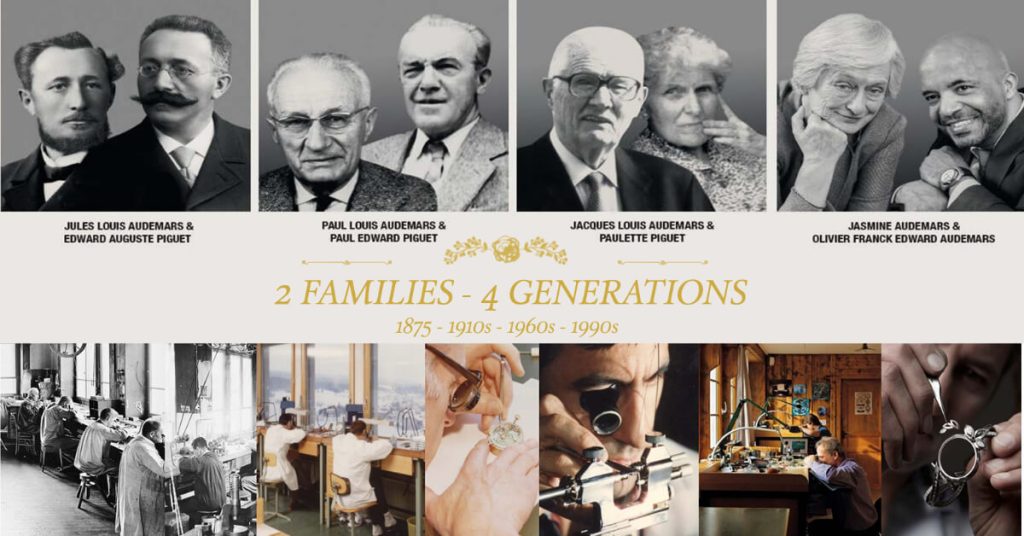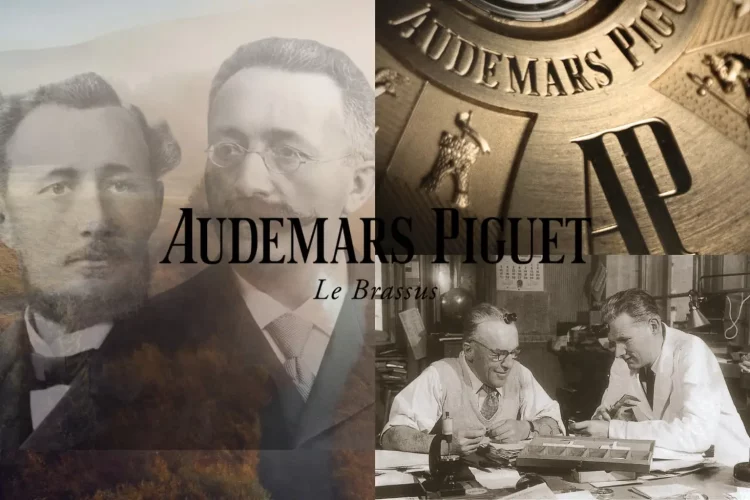Audemars Piguet
Audemars Piguet is one of the most renowned names in luxury watchmaking, synonymous with unparalleled craftsmanship, innovation, and iconic designs. Founded in 1875 in the Vallée de Joux, Switzerland, the brand has not only shaped the course of horology but also defined what it means to own a watch of the highest caliber. For over a century, Audemars Piguet has produced timepieces that blend precision, artistry, and exclusivity, gaining a place in the hearts of collectors, connoisseurs, and celebrities worldwide.
This article delves into the rich history and evolution of Audemars Piguet, examining its beginnings, landmark achievements, iconic watch collections, collaborations, and its profound influence on both the luxury watch industry and popular culture.
I. The Origins of Audemars Piguet
1. Founding of Audemars Piguet: A Vision of Innovation
Audemars Piguet was founded by Jules-Louis Audemars and Edward-Auguste Piguet in 1875 in the picturesque village of Le Brassus, located in Switzerland’s famed Vallée de Joux, the heart of Swiss watchmaking. The two young men shared a passion for horology and an ambition to create timepieces that combined the highest quality craftsmanship with innovative technical features.
Audemars, the son of a watchmaker, had grown up in the watchmaking trade, and Piguet, with his strong technical background, provided the perfect complement. Together, they founded the company with the goal of crafting the most exceptional watches, incorporating advanced mechanical movements and revolutionary designs. This vision set the stage for Audemars Piguet to become a leader in the world of luxury timepieces.
2. Early Years: Crafting Complicated Movements
In the early years, Audemars Piguet focused on creating complicated pocket watches for an elite clientele. The company quickly earned a reputation for its intricate mechanisms and fine craftsmanship. One of the first great achievements of the brand was its ability to produce some of the most complex movements of its time, including perpetual calendars, minute repeaters, and chronographs.
These highly complex complications placed Audemars Piguet at the forefront of Swiss watchmaking, with timepieces that were as much about technical achievement as they were about aesthetics. Early models, like the Minute Repeater (developed in 1882), showcased the brand’s commitment to combining artistry with precision.
II. Innovation and Evolution: The Royal Oak Revolution
While Audemars Piguet’s early history was defined by its technical innovations and complex movements, it was the Royal Oak that truly transformed the brand and revolutionized the luxury watch industry.
1. The Birth of the Royal Oak: Gérald Genta’s Iconic Design
The Royal Oak, designed by Gérald Genta in 1972, is perhaps the most significant milestone in the history of Audemars Piguet and one of the most iconic luxury watches ever created. Genta’s design was groundbreaking—prior to the Royal Oak, luxury watches were typically made of precious metals like gold and were often seen as formal or dress watches. The Royal Oak was the first luxury sports watch made entirely of stainless steel, a material that was previously considered too utilitarian for high-end watches.
What made the Royal Oak truly revolutionary was not only its use of stainless steel but also its distinctive octagonal bezel, exposed screws, and integrated bracelet—features that set it apart from any watch that had come before it. The design was bold, modern, and unorthodox, making it a statement piece for those who sought to stand out from traditional luxury watch owners.
2. The Impact of the Royal Oak on Audemars Piguet
The launch of the Royal Oak marked a turning point for Audemars Piguet. Initially met with skepticism, the watch quickly gained traction and became one of the most sought-after timepieces in the world. It was no longer just a watch; it was a symbol of exclusivity, luxury, and innovation. The Royal Oak demonstrated that a steel sports watch could combine both elegance and functionality, making it suitable for a wide range of occasions, from casual settings to formal events.
This revolutionary design not only reshaped the image of Audemars Piguet but also had a lasting impact on the entire luxury watch industry. It inspired other brands, including Patek Philippe and Vacheron Constantin, to release similar models, thus giving birth to the category of luxury sports watches.
3. The Evolution of the Royal Oak: From Offshore to Jumbo
Following the success of the original Royal Oak, Audemars Piguet continued to innovate with the model, introducing various versions and complications. One of the most significant evolutions of the Royal Oak was the introduction of the Royal Oak Offshore in 1993. Designed to be more robust and sporty, the Offshore model featured a larger case, screw-down pushers, and rubberized elements, making it more suitable for active lifestyles and outdoor pursuits.
The Royal Oak Jumbo, a thinner version of the original design, was also introduced in the 1980s, and over the years, the Royal Oak has remained a cornerstone of the Audemars Piguet collection. The Royal Oak Concept models, which feature cutting-edge materials like ceramic and titanium, continue to push the boundaries of watchmaking.

III. Craftsmanship and Technology: The Heart of Audemars Piguet
At the core of every Audemars Piguet timepiece is a commitment to technical excellence, masterful craftsmanship, and innovation. The brand’s movements are renowned for their precision, complexity, and durability.
1. The Art of Movement Making
Audemars Piguet is known for producing its own movements in-house, a process that requires both skill and expertise. The company’s master watchmakers create intricate mechanical movements that are not only technically advanced but also beautifully finished. Some of the most complex movements produced by Audemars Piguet include the tourbillon, perpetual calendar, and minute repeater.
Each movement is carefully assembled, regulated, and tested by Audemars Piguet’s highly trained technicians, ensuring that every timepiece meets the brand’s exacting standards of performance and precision. The movement is often the heart and soul of an Audemars Piguet watch, and its meticulous craftsmanship contributes to the watch’s intrinsic value.
2. Pioneering Materials and Innovation
Audemars Piguet has always been at the forefront of using innovative materials in its watches. The brand was one of the first to use stainless steel for luxury watches, and it continues to push the boundaries by experimenting with materials such as titanium, carbon fiber, and ceramic.
The Royal Oak Offshore models, for example, often feature high-tech materials like forged carbon and rubber to enhance durability and reduce weight. The brand’s commitment to utilizing cutting-edge materials helps ensure that its watches are both technically superior and visually striking.
3. Complicated Watches: Pushing the Limits of Engineering
Audemars Piguet is also known for its complicated timepieces—watches that incorporate complex functions such as minute repeaters, chronographs, tourbillons, and perpetual calendars. These complications require a high level of expertise and attention to detail, as they demand exceptional engineering and precision in design.
The Royal Oak Concept collection, in particular, features avant-garde designs and highly complex movements, blending futuristic aesthetics with traditional watchmaking techniques. These timepieces are not just functional; they are works of art, representing the pinnacle of craftsmanship and horological innovation.
IV. The Legacy and Influence of Audemars Piguet
Audemars Piguet’s influence extends far beyond the watchmaking industry. The brand has had a profound impact on the culture of luxury, and its timepieces are highly coveted by collectors and enthusiasts worldwide.
1. A Symbol of Prestige
Audemars Piguet watches are not just about telling time; they are symbols of prestige, success, and taste. Owning an Audemars Piguet is a mark of distinction, and the brand’s timepieces are often seen on the wrists of celebrities, business leaders, and high-profile athletes.
The Royal Oak, in particular, has become a cultural icon, representing the perfect blend of luxury and functionality. It is a watch that transcends mere utility and embodies the ideals of modern sophistication.
2. Collaborations and Partnerships
Audemars Piguet’s influence is further bolstered by its collaborations with various artists, athletes, and designers. The brand has partnered with Formula 1 drivers like Sebastian Vettel and LeBron James, and it has worked with renowned artists
like Richard Mille and Jared Leto on limited-edition pieces. These collaborations enhance the brand’s visibility and appeal, attracting a new generation of collectors.
3. The Audemars Piguet Heritage: A Future of Innovation
As Audemars Piguet looks to the future, the brand continues to innovate while maintaining its dedication to craftsmanship and tradition. With an unwavering commitment to quality, precision, and design, Audemars Piguet remains one of the most respected and influential names in the luxury watch industry.
V. Conclusion: The Timeless Legacy of Audemars Piguet
From its humble beginnings in 1875 to its status today as one of the most prestigious names in watchmaking, Audemars Piguet has set the bar for craftsmanship, design, and innovation. The brand’s legacy is defined by iconic models like the Royal Oak, a timepiece that forever changed the landscape of luxury sports watches.
Audemars Piguet continues to lead the way in the world of horology, combining cutting-edge technology with age-old craftsmanship. Its timepieces are not just functional objects but symbols of artistry, prestige, and timeless elegance—an enduring testament to the brand’s commitment to excellence.





































